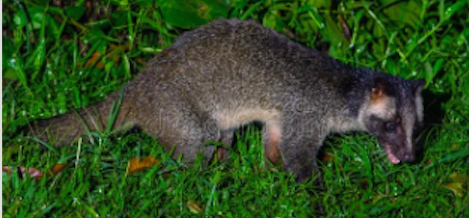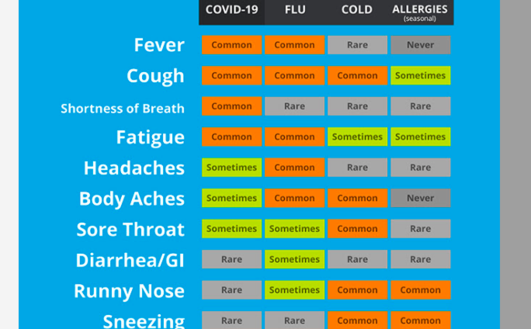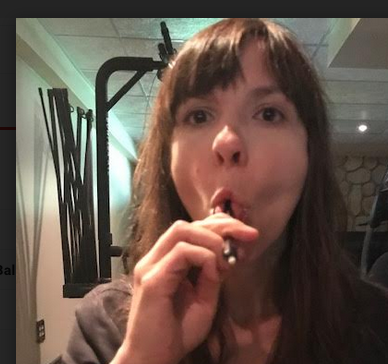Holistic Orthodontics in a Northern California
Text or Call
Cell: 212-912-1212
STRATEGIES for coping during Pandemic
Breathing Exercise: Seal your lips. Place your tongue to the roof of your mouth(the hard palate) behind the front teeth. With your lips together and your tongue up, breathe in thru the nose to the count of 3. Breathe out thru the nose to the count of 5. Still with your mouth shut and your lips sealed, hum. Hum as if you are chanting Aum, or as if you are a monk. Still lips sealed and nasal breathing, now swallow.
What this exercise does is to tone the Vagus nerve, the 10th cranial nerve, which gives you a sense of well-being. The vagus controls humming and swallowing and carries parasympathetic fibers which are part of the Autonomic Nervous System and these enable CALMING. Nasal breathing releases more NITIRIC OXIDE (not nitrous oxide known as laughing gas) and nitric oxide disrupts the coronavirus
Nitric Oxide Inhibits the Replication Cycle of Severe Acute Respiratory Syndrome Coronavirus
Sara Åkerström, Mehrdad Mousavi-Jazi, Jonas Klingström, Mikael Leijon, Åke Lundkvist, Ali Mirazimi
DOI: 10.1128/JVI.79.3.1966-1969.2005
ArticleFigures & DataInfo & Metrics
PDF
ABSTRACT
Nitric oxide (NO) is an important signaling molecule between cells which has been shown to have an inhibitory effect on some virus infections. The purpose of this study was to examine whether NO inhibits the replication cycle of the severe acute respiratory syndrome coronavirus (SARS CoV) in vitro. We found that an organic NO donor, S-nitroso-N-acetylpenicillamine, significantly inhibited the replication cycle of SARS CoV in a concentration-dependent manner. We also show here that NO inhibits viral protein and RNA synthesis. Furthermore, we demonstrate that NO generated by inducible nitric oxide synthase, an enzyme that produces NO, inhibits the SARS CoV replication cycle.
Severe acute respiratory syndrome (SARS), which is associated with a novel coronavirus (CoV), was first identified during fall 2002 in Guangdong Province, China (24, 32, 34). The mortality rate of SARS appears to range from 6 to 55% (12, 20, 21). Coronaviruses are enveloped single-stranded positive-sense RNA viruses with genomes of about 27 to 30 kb (21). Coronaviruses belong to the family Coronaviridae, in which SARS CoV forms a distinct group within the genus Coronavirus (9, 29).
Nitric oxide (NO) is an important signaling molecule between cells and is involved in a wide range of processes (9, 27). An antimicrobial activity of NO has been described for several bacteria and protozoa and for some viruses (1, 18, 27). NO is produced by three enzymes that catalyze the oxidation of l-arginine to NO and l-citrulline (9). Two of the enzymes, neuronal nitric oxide synthase (nNOS) and endothelial NOS (eNOS), are constitutively expressed and are calcium dependent (27). Inducible NOS (iNOS) is expressed only in activated cells and is calcium independent (11). The up-regulation of iNOS is common during an infection, and it is known that some viruses and bacteria are either inhibited or stimulated by increased levels of NO (1, 2, 11, 26, 30). It has also been demonstrated that iNOS is expressed after interferon stimulation in murine macrophages, mouse T cells, human hepatocytes, mononuclear cells, human airway epithelial cells, and alveolar macrophages (6, 13, 15, 25, 31, 33).
The Coronavirus Pandemic has changed all our lives. First, let me wish you good health and continued joy in life.
Coronavirus is virulent and spreads quickly. Even more significant, one cannot tell from appearances whether an individual is contagious. The way to control the spread and infecting yourself and others is through SOCIAL DISTANCING, disciplined infection control, following the CDC control recommendation for vaccine, booster and wearing a protective mask.
This means:
1.Wear a mask or facial cover up-mainly to keep you from spreading viral particles when you talk, cough, or sneeze and to keep your hands from touching your face, getting viral particles on your hands and then touching stuff, called “fomites.”
2. Stay physically away from others
3. Wash your hands frequently with warm water and soap and remember to wash under your fingernails. In one infection control course I took, the lecturer showed us how microorganisms hide under your fingernails.
4. Disinfect surfaces (fomites) with greater than 70% alcohol solution or bleach or iodine.
5. Be careful of contact with customers in stores or in public, as the latest data shows that greater than 50% of people can be carriers of Covid-19 and show NO symptoms.
I have also been listening to many Webinars on health and reading emails, and I want to share with you easy ways to stay healthy. You probably know many of these anyway, but repetition reinforces.
What causes us to lose our health?
We are invaded by dis-ease. Generally, this is an onslaught from an organism, like a bacterium or a virus, or other microorganisms, or environmental toxins, contaminated foods and drinks, and other people.
Emotional factors affect our health--burnout, stress, anxiety, and depression because health is not only physical--it is also mental and emotional.
Whether the INVADER establishes ground in us depends on how strong we are. So let’s get strong so any attack that comes our way meets resistance. Let’s prevent susceptibility to dis-ease.
One major way is diet. What foods do we eat? What do we drink?
PROTEIN is the most important nutrient in supporting a strong immune system. I know I will get a loud shout-back from vegetarians, vegans, and my own ‘SWEET TOOTH,’ but I know that eating high protein, high fat, and low carbohydrate, actually NO SUGAR, is the best way to maintain health. Sugar is the hidden ingredient in too many foods, like bread and pasta, as it is not the food you eat but how that food is metabolized. If the food is converted into glucose, that is sugar, there is a rise in insulin and a drain your physiology.
Bread is metabolized to glucose, as is beans, pasta, fruits, and alcohol. One cup of soybeans has 56g of carbohydrates. One g of carbs raises blood sugar 4 mg/dl.
Sugar in any form is a poison, but we love it! In the sixties, the sugar industry paid off scientists to put the blame for heart disease on fat instead of sugar. Coca Cola paid millions to researchers to play down the link between sugary drinks and obesity. This was reported in JAMA Internal Medicine, September 2016. Sugar is the substrate for cancer cells, squamous cancer cells particularly. Sugar as a liquid is the worst.
A family member told me he was pre-diabetic, had unexplained weight gain, high blood pressure, and could not understand why, as he ate only organic foods and mostly protein such as fresh fish and healthy dark green vegetables. What he forgot to consider was that he likes to drink and go out to the bars--his way of celebrating is to have a drink in hand.
A friend, who loved to drink, was very ill with cancer. I told him that his cancer lived off sugar. He immediately stopped drinking and made vodka ice cubes to put in his water. But he was a humorist from SNL Prime Time Players.
From Healthline: “When you drink alcohol, your body metabolizes it before other nutrients, which slows down your metabolism and results in excess body fat.”
Obesity, which results from a diet too high in sugar, is nearly epidemic in our country.
Headline: NYTIMES April 16, 2020:
Obesity Linked to Severe Coronavirus Disease
Like sugar, obesity causes chronic, low-grade inflammation and increases cytokines resulting in the worst Covid-19 outcomes. 42% of Americans are obese! The studies declare that obesity is not a lifestyle choice but a medical disorder that predisposes an individual to getting ill; however life style choices can play a role in curing this dis-ease.
LIFE STYLE CHOICES
#1: DIET
#2: EXERCISE! Yes that is a command. Once I was an English teacher and I can tell you, that a verb standing alone presupposes YOU as the noun or pronoun! Exercise is the major way to keep you and your family healthy. For children, jumping on a trampoline and martial arts are great. Anything that keeps the body moving is exercise. I live in the country and walking in nature, especially now that spring is here, moving in the sun, on trails in the woods, I move my body and my mind becomes still and present with the moment.
#3:SLEEP
We used to belittle sleep and consider working all night, pulling an ‘all-nighter’ we called it, to complete a project or write a piece or create art, admirable, but it is not. Many studies have shown that 8 hours a night of sleep not only refreshes the body but also makes the mind work better, improves memory, and facilitates creativity and problem solving. While we sleep our organs heal. Have you ever wondered why you wake up at certain times every night? For example, if you get up at 3 am, it may be low blood sugar due to eating too much sugar too close to bedtime, or, according to Chinese medicine (TCM), 1-3 am is the time for the liver to repair. If you wake up between 3 am and 5 am, it could be due to an imbalance in your lungs, specifically breathing. Therefore, any disruption to your sleep has meaning. Either your organ systems are upset, you have stress, or there is something blocking your ability to take deep, proper breaths. This could be sleep apnea. You lose your breath and you wake up gasping, for oxygen. Snoring often precedes sleep apnea. And this exists even in children.
The major causes of sleep apnea, often called OBSTRUCTIVE SLEEP APNEA is the malposition of the tongue, blocking the airway passages, mouth breathing, malocclusion or misalignment of the teeth and the jaws that constricts the face and narrows the palate, the jaws, and blocks the easy flow of air through the respiratory tract into the lungs. The tongue, instead of resting on the roof of the mouth behind the front teeth, thrusts forward and rests between the teeth. The cause of this is a MISFIT between the size of the tongue and the size of the palate as well as loss of voluntary control of the tongue muscles. We cannot make the tongue smaller (only in Shakespearean tragedies does this happen) but we can expand the palate. We can also train the tongue not to thrust forward, in speech and swallowing, using myofunctional exercises.
I recommend exercises for proper tongue placement, speech enunciation, tongue strengthening, breathing, and swallowing.
In the time of a pandemic that affects your lungs, these exercises can not only help your lung capacity but also help you manage stress by toning your autonomic nervous system- the fight and flight or relax and have equanimity nervous system. In addition, swallowing and humming support the Vagus nerve, the 10th Cranial nerve, the biggest and longest that has so many functions, including stabilizing the heart rate and making you feel calm and comforted.
VAGUS is Latin for WANDERING, and this nerve travels from the head to the gut. Ever wonder why you feel ‘butterflies in the stomach” when you get anxious? It’s the vagus nerve. How about I have a gut feeling? And it is your intuition- your autonomic nervous system.
Tongue exercises
1. Around the world- run your tongue around the inside on your lips, top and bottom in a complete circle for several rotations. Keep your lips sealed. Switch to the other direction and repeat.
2. Granny surprise- pucker lips and breath through the nose with lips closed in the pucker and raise eyebrows as you breathe in. Keep lips sealed.
3. Hum and swallow- keep lips closed and teeth apart by biting on a stick or cotton roll. Keep the tongue on the roof of your mouth with your lips sealed, forcing you to breathe through your nose. Breathe in slowly and deep for a count of 3
Breathe out for a count of 5
Hum, and swallow.
Repeat 3 times
4. Tongue stretch- start by putting the tongue on the roof of your mouth behind the front teeth. Then stretch your tongue outward as far as you can to touch your chin. Stretch it side to side and then up toward your nose. Bring it back in your mouth to the roof of your mouth and repeat.
5.The Cup or the Taco- make a cup with with your tongue, or curl it. sticking it out slightly. Breathe in through your nose, or your mouth. Breathe out through your mouth. This is the only exercise where you can do mouth breathing. Keep the tongue cupped, puffing the cheeks out on the exhale, exercising your buccinator muscle, like a fish.
6. Flatten your tongue on the palate behind the front teeth. Make clucking sound. This is difficult but persevere.
7. Place the tip of the tongue on the palate behind the front teeth. Put the lower lip over the upper lip, sealing the lips, so the vermillion of the lip does not show. Say pop, attempting to keep the lips together and breathing through the nose.
These exercises will help you with proper tongue placement (ROOF OF MOUTH), Strengthening tongue muscles, and NASAL BREATHING.
NASAL BREATHING IS THE WAY TO GO
This is true not only in the time of Coronavirus (see the abstract above) but also at all times. When we breathe through our nose, nasal resistance helps in the release of OXYGEN and the sinuses produce Nitirc Oxide.
From the American Journal of Respiration and Critical Care Medicine
HUMMING Greatly Increases Nasal Nitric Oxide
Feb 22, 2002 - The paranasal sinuses are major producers of nitric oxide (NO). ... by humming you would enhance sinus ventilation and thereby increase nasal NO levels. ... 96% during phonation and less than 4% during quiet breathing (n = 6).
Do each exercise once a day, or more.
Good luck!
Stay far away from this horseshoe bat! This is the frightening Coronavirus animal host !
Yin Yoga demo of how to relax the jaw. With mouth open, one hand on the cheek muscle-the buccinator-the other hand on the hard bone of the lower jaw where the ramus and the body of the mandible meet--gently and lightly move your hands together, hold, unwind, let go.
All news these days focuses on Covid-19, and for any of us, who are suggestible, and open, it is easy to think that we may be infected, especially as the data says that many people are asymptomatic. Yet, with the new evidence showing that people in their 30's,40's,and 50's, could have strokes, as a sign of Covid-19, how are we to know when we are ill? When do we have allergies and not covid-19, considering the Hudson Valley in the Springtime is often called Allergy Paradise, and a cough and a headache could be symptoms of allergies as well as Covid-19?
Please follow a healthy diet, and I apologize for repeating myself, but keep the sugar and the foods that are metabolized to glucose, to a minimum and that means foods such as bread, pasta, cookies, cake, muffins, scones, candy, soda, juice. Snack on low carbs-nuts, nut butters, paleo crackers, cheeses if you are not dairy-sensitive, and goat and sheep are better than cow if you are dairy-seimi-intolerant, celery, carrots (very sweet vegetable with high sugar so only a few), broccoli (my healthiest dental assistant-a beautiful woman- snacked on broccoli florets), exercise and walk outside even 40 minutes a day, and have a mediation or mindfulness practice-whether it be yoga, taichi, qi gong, listening to calming music--anything that slows you down and helps you rest. And get good sleep-8 hours.
Horseshoe Bat carrier Coronavirus-stay away!
Cup or Taco tongue exercise
Tongue stretch: Note the stretching of the frenum or fibrous attachment, that band of tissue-STRETCH it--even take qtip or thin wooden coffee stirrer and wiggle it to soften it









